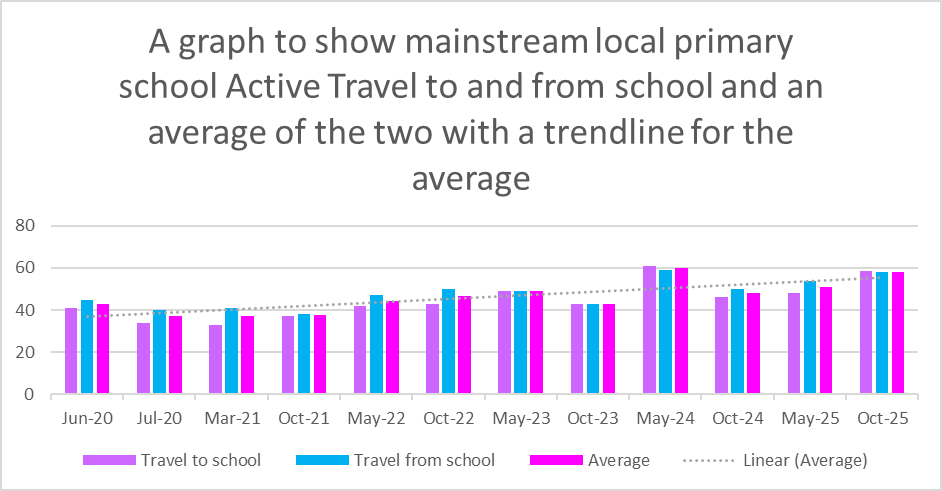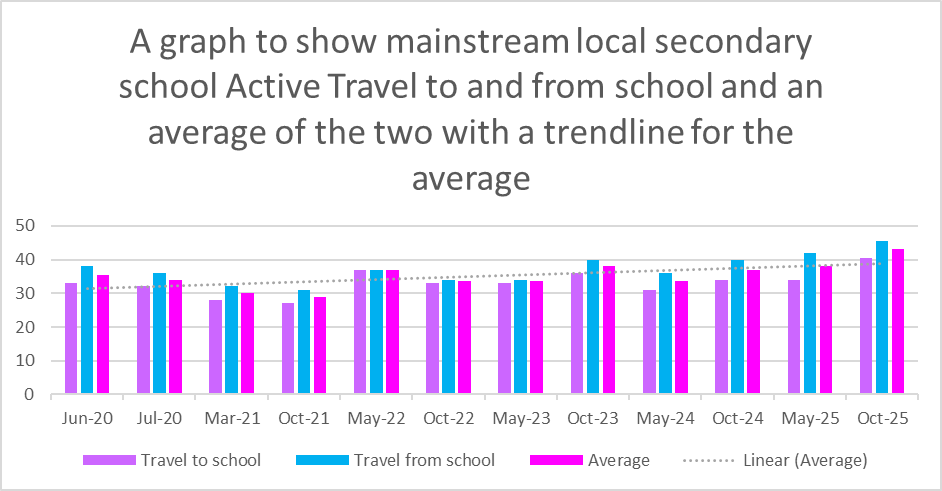We are working with schools to support children and families to walk, cycle or consider blended travel when travelling to and from school.
Our project work has included:
- Liaising with schools to encourage and help set up walking buses, park and stride and cycle trains and engaging with school councils and right's respecting groups.
- Working with Traffic and Highway Services to undertake travel plans for all primary schools, leading to improvements to cycle parking, crossing points and pavements.
- Supporting St Martins Primary school active travel project to create Guernsey's first School Street. Listen to the schools journey, how they empowered the children, gathered evidence and showed resilience in the face of barriers here St Martins School. Now no children are dropped off by car at the school gate aside from breakfast club and the playground is no longer used as a pickup point by cars at the end of the day.
- Helping local primary schools take part in the living Streets WOW challenge. Children use a Travel Tracker to record how they get to school each day. If they walk, cycle or scoot once a week for a month they collect a badge.
Email alex.coston@healthimprovement.gg to find out more.
Findings of the School Active Travel Survey 14th and 15th October 2025
Pedal Power is Booming!
· Active travel in Bailiwick of Guernsey schools continues to rise and appears to be gaining momentum with more and more students choosing to cycle.
· Active travel to and from primary schools has increased by 10% points in just 12 months since the October 2024 audit, from 48% to 58%. Cycling has increased by 7% points over this period.
· Active travel to and from secondary schools has increased by 6% points over the same 12-month period since the October 2024 audit, from 37% to 43%. Cycling has increased by 6% over this period.
Are motorcycles becoming a thing of the past for young people?
When comparing the May 2024 secondary schools travel audit with the most recent audit in October 2025 we found that:
· Motorcycle use dropped in secondaries from 9% to 2% (a decrease of 7 percentage points).
· Bicycle use in secondaries increased from 15% to 19% (an increase of 4 percentage points).
· The gap widened significantly: bicycles are now 17% points higher than motorcycles in local secondary schools, compared to 6% points higher 18 months ago.
Our recent work with secondary schools and the Sixth Form Centre - alongside initiatives like St Sampsons’ School Street and other sustainable strategies - are demonstrating that long-term behaviour change is achievable, with schools consistently reporting year-on-year increases in active travel.
A particularly noteworthy trend is that as cycling becomes more and more popular among secondary students, motorcycle use is falling. This widening gap may reflect the increasing appeal of electrically assisted pedal cycles (E-bikes), making cycling more accessible, convenient, and attractive for young people.
At the Health Improvement Commission, the Be Active team is committed to helping more people be more active, more often. Walking or cycling to school regularly is one of the simplest ways to build physical activity into daily life. We aim to make the school run a healthy, fun experience for all - supporting initiatives like School Streets and advocating for improvements such as increased bicycle parking to make active travel the easier choice.
Our ongoing challenge is to sustain the momentum from Cycle to School Week. We’re keen to support more schools with their travel plans, working closely with the Traffic and Highways team, and expanding initiatives like our ‘Learn to Ride’ after-school club. This helps prepare students for Bikeability training. Bikeability continues to deliver excellent, inclusive cycle training in schools, and we’re now looking to extend our focus to adult cycling skills - empowering whole families to feel confident cycling together which in-turn supports schools in achieving more active travel and reducing congestion around their sites.
Summary of the Active Travel Survey
The Active Travel Audit was introduced by the Health Improvement Commission in 2020 and since 2022 has been conducted twice a year in May and October. All schools ask children in each class how they travelled to and from school over two consecutive days. Active Travel is defined as walking, cycling, scooting and blended travel, whereby someone might travel part of the journey by motorised vehicle and complete their journey by an active travel mode, sometimes referred to as ‘Park and Stride’.
Primary School Results
The average numbers of primary school pupils incorporating walking, cycling and scooting into their school journeys shows a positive trend over time.
Rates of to school and from school active travel follow a similar pattern, with gradual growth and periodic fluctuations.
The average percentages of primary school children walking, cycling, scooting or using blended travel to and from school is 58%.
These are the highest active travel results recorded for an Autumn survey and are only 2% points off our highest ever recorded rates from May 2024 when we saw a significant spike in active travel following the success of Guernsey’s first ever School Street at St Martins Primary school and a few other schools offering walking buses at the time.

Secondary School Results
With La Mare de Carteret closing last year and pupils being spread amongst the remaining secondary schools, it is harder to compare individual school results with previous audits, however, the average numbers of secondary aged pupils incorporating walking, cycling and scooting into their journeys shows a steady upward trend.
Notably, the data suggests that morning ‘to school’ travel is improving at a faster rate than ‘from school’, with 40% of students travelling actively to school in October 2025, up 6% points since May 2025. This is positive news for student health and morning ‘rush hour’ vehicle congestion and could be due to secondary schools trialling School Streets. 45% of students reported travelling actively from school, up 3% points since May 2025 and this means the average active travel rate of 43% is the highest since records began.
The increase in active travel amongst secondary schools comes with thanks to the Active Travel Steering Group that has been established, including a representative from each secondary school, Traffic and Highways and the Health Improvement Commission with the aim to work collaboratively to identify and remove barriers to active travel, making it an easier and more attractive option for secondary pupils.
